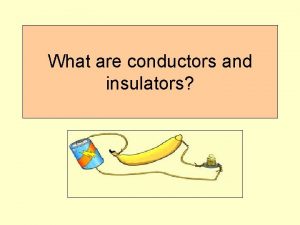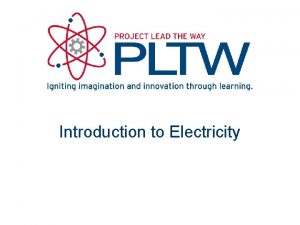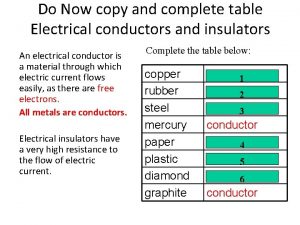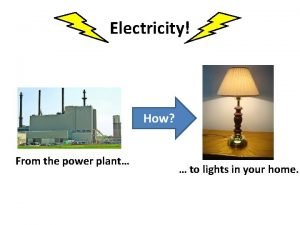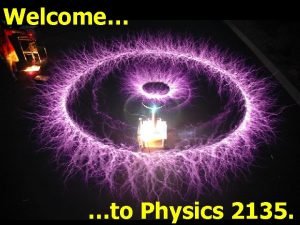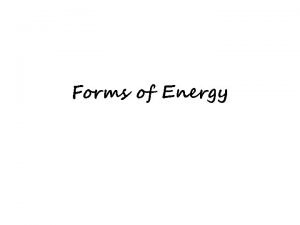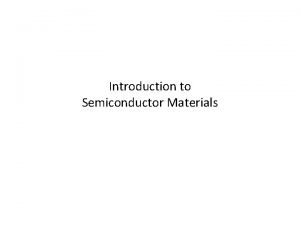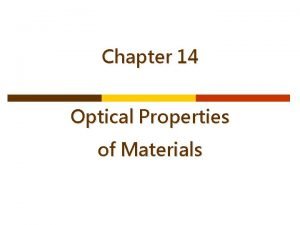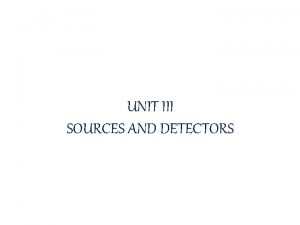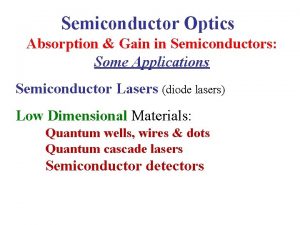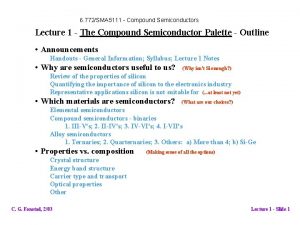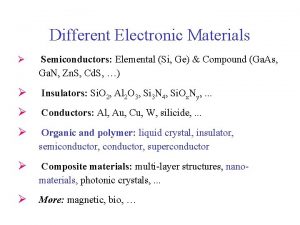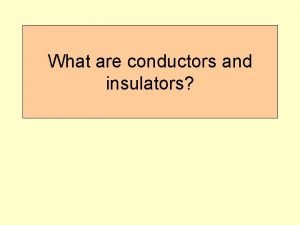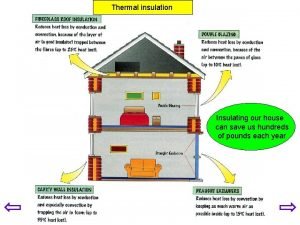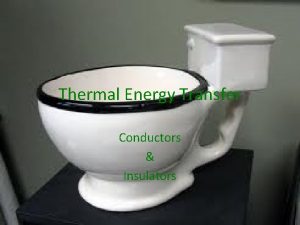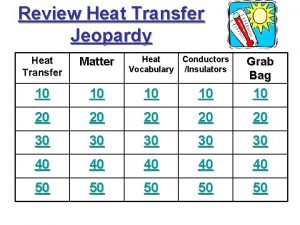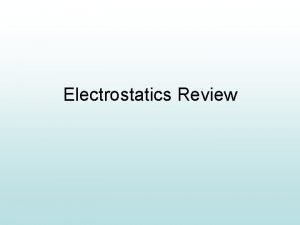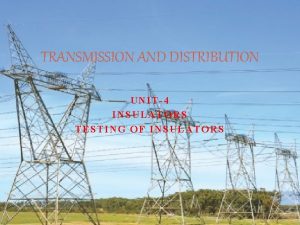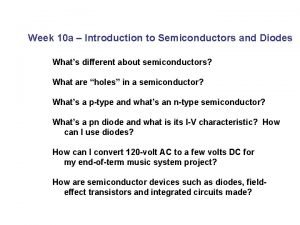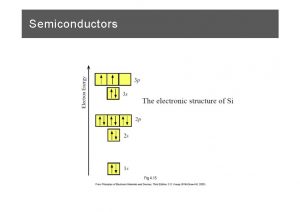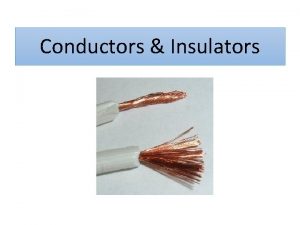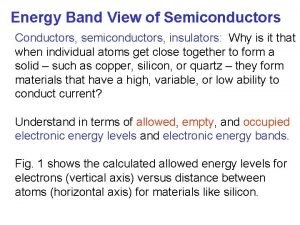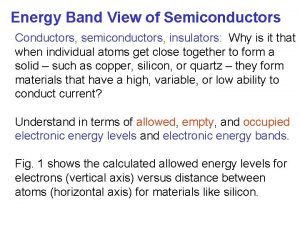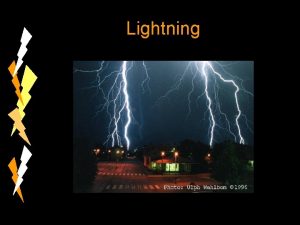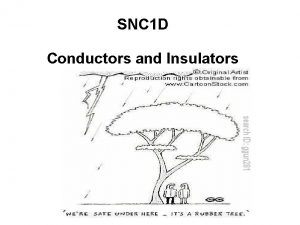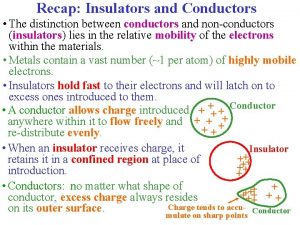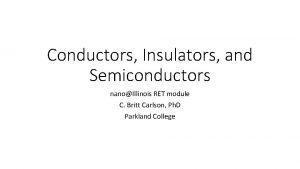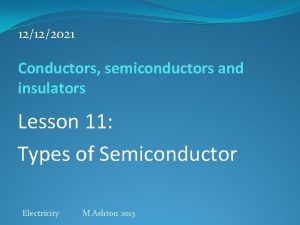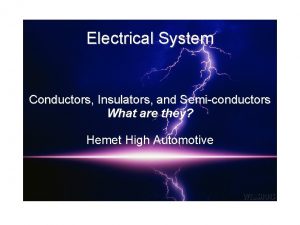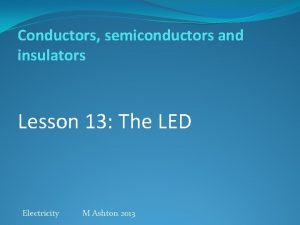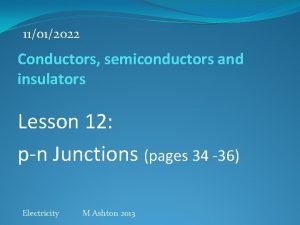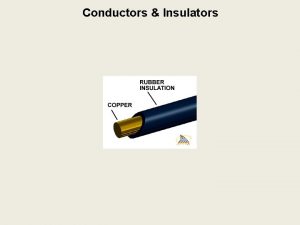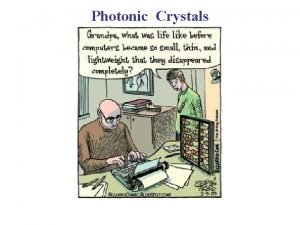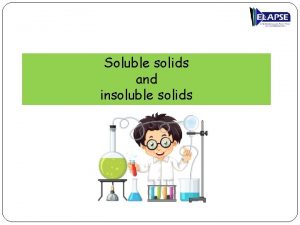Semiconductors Outline Crystals Atomic Solids Conductors and Insulators
































- Slides: 32

Semiconductors Outline - Crystals: Atomic Solids - Conductors and Insulators - Doped Semiconductors

Bonding Between Atoms How can two neutral objects bind together? H + H H 2 +e -e Superposition of Coulomb potentials H 2: r n=3 n=2 energy of -e -e +e +e n=1 +e r energy of -e Let’s represent the atom in space by its Coulomb potential centered on the proton (+e): Continuum of free electron states

Molecular Wavefunctions +e Atomic ground state: (1 s) n=1 1 s energy Molecular states: +e +e r r +e +e r 1 s energy Bonding state Antibonding state

Tunneling Between Atoms in Solids Again start with simple atomic state: energy of -e -e +e r n=1 energy of -e Bring N atoms together forming a 1 -d crystal (a periodic lattice)… -e

Let’s Take a Look at Molecular Orbitals of Benzene … the simplest “conjugated alkene” H H C 1. 08 Å C Typical C-C bond length 1. 54 Å Typical C=C bond length 1. 33 Å H C or 1. 395 Å C H C C H Length of benzene carbon-carbon bonds is between C-C and C=C bond lengths H p orbitals p-electron density © Source unknown. All rights reserved. This content is excluded from our Creative Commons license. For more information, see http: //ocw. mit. edu/fairuse.

ELECTRONEnergy ENERGY Electron Molecular Orbitals of Benzene Energy distribution of Benzene p-molecular orbitals Carbon atoms are represented by dots Nodal planes are represented by lines © Source unknown. All rights reserved. This content is excluded from our Creative. Commons license. For more information, see http: //ocw. mit. edu/fairuse. Energy antibonding MOs energy of isolated p-orbital bonding MOs from Loudon

… More Examples – Series of Polyacene Molecules Molecule Benzene Absorption The lowest bonding MO of anthracene … LOWEST ENERGY ABSORPTION PEAK AT … 255 nm Naphthaline 315 nm Anthracene 380 nm Tetracene 480 nm Pentacene 580 nm 496 © Source unknown. All rights reserved. This content is excluded from our Creative. Commons license. For more information, see http: //ocw. mit. edu/fairuse. 397 330 283 (nm) Red: bigger molecules ! Blue: smaller molecules ! 20000 25000 Luminescence Spectra 35000 30000 ENERGY cm-1

From Molecules to Solids 0 nodes 1 node 0 nodes ………………… N-1 nodes Number of atoms = number of states

1 -D Lattice of Atoms Single orbital, single atom basis Adding atoms… • reduces curvature of lowest energy state (incrementally) • increases number of states (nodes) • beyond ~10 atoms the bandwidth does not change with crystal size Decreasing distance between atoms (lattice constant) … • increases bandwidth

Consider a set of quantum wells

Ground state solution

First excited state solution

Second excited state solution

Interpretation of the Wavefunction Shapes • Envelope of wavefunction seems to work like wavefunction for a particle in a box • Wavefunctions local to a single well look like ground state wavefunction for a well in isolation • Same kind of effect occurs with atomic potentials instead of quantum well potentials

From Molecules to Solids N-1 nodes 0 nodes N atoms N states Closely spaced energy levels form a “band” of energies between the max and min energies

Approximate Wavefunction for 1 -D Lattice Single orbital, single atom basis k=0 a (crystal lattice spacing) k≠ 0 k = π/a k is a convenient way to enumerate the different energy levels (count the nodes) Bloch Functions:

Energy Band for 1 -D Lattice Single orbital, single atom basis highest energy (most nodes) lowest energy (fewest nodes) • Number of states in band = number of atoms • Number of electrons to fill band = number of atoms x 2 (spin)

From Molecules to Solids +e r 2 s energy n=2 1 s energy n=1 N states Bands of “allowed” energies for electrons Bands Gap – range of energy where there are no “allowed states” The total number of states = (number of atoms) x (number of orbitals in each atom)

Bands from Multiple Orbitals Atom +e Solid Example of Na r Z = 11 1 s 22 p 63 s 1 Image in the Public Domain n=3 n=2 n=1 These two facts are the basis for our understanding of metals, semiconductors, and insulators !!! • Each atomic state a band of states in the crystal These are the “allowed” states for electrons in the crystal Fill according to Pauli Exclusion Principle • There may be gaps between the bands These are “forbidden”energies where there are no states for electrons What do you expect to be a metal ? Na? Mg? Al? Si? P?

What about semiconductors like silicon? Fill the Bloch states according to Pauli Principle Z = 14 1 s 22 p 63 s 23 p 2 Total # atoms = N Total # electrons = 14 N 3 s, 3 p 4 N states 2 s, 2 p 4 N states 1 s N states 2 N electrons fill these states It appears that, like Na, Si will also have a half filled band: The 3 s 3 p band has 4 N orbital states and 4 N electrons. 8 N electrons fill these states By this analysis, Si should be a good metal, just like Na. But something special happens for Group IV elements.

Silicon Bandgap Fill the Bloch states according to Pauli Principle Z = 14 1 s 22 p 63 s 23 p 2 Total # atoms = N Total # electrons = 14 N 4 N states 3 s, 3 p 2 s, 2 p 4 N states 1 s N states 2 N electrons fill these states The 3 s-3 p band splits into two: 8 N electrons fill these states Antibonding states Bonding states

Conduction and Band-filling Metal Insulator The electrons in a filled band cannot contribute to conduction, because with reasonable E fields they cannot be promoted to a higher kinetic energy. Therefore, at T = 0, Si is an insulator. At higher temperatures, however, electrons are thermally promoted into the conduction band.

Electron States in Silicon Electronic Conduction in a Semiconductor - example: Si Z = 14 1 s 22 p 63 s 23 p 2 valence electrons Empty band at T = 0. (Conduction Band) 3 s/3 p band Energy Gap Egap ≈ 1 e. V Filled band at T = 0 (Valence band) The electrons in a filled band cannot contribute to conduction, because with reasonable E fields they cannot be promoted to a higher kinetic energy. Therefore, at T = 0, Si is an insulator. At higher temperatures, however, electrons are thermally promoted into the conduction band.

Making Silicon Conduct Consider electrons in a semiconductor, e. g. , silicon. In a perfect crystal at T=0 the valence bands are filled and the conduction bands are empty no conduction. Which of the following could be done to make the material conductve? a. heat the material b. shine light on it As we increase the temperature, such that k. T Egap, some electrons are excited to the conduction band As we shine light on the material (with energy Ephoton > Egap), electron-hole pairs are created c. add foreign atoms that change the number of electrons “Donor” atoms (like P) have extra electrons to add to the crystal. The electrons are “donated” to the conduction band they can conduct electricity. “Acceptor” atoms (like B) have fewer electrons and they “accept” electrons from the crystal. This leaves missing electrons – called “holes” in the valence band so that it is not completely filled and can conduct electricity.

Images in the Public Domain

Controlling Conductivity: Doping Solids Silicon crystal Extra electron Conduction Band (partially filled) (Unfilled) Valence Band Boron atom (5) hole IIIA ACCEPTOR DOPING: P-type Semiconductor Dopants: B, Al (filled) (partially filled) IVA VA VIA Arsenic atom (33) DONOR DOPING N-type Semiconductor Dopants: As, P, Sb Image in the Public Domain

Making Silicon Conduct Metal Insulator or Semiconductor T=0 Semi. Conductor T≠ 0 n-Doped Semi. Conductor

Controlling Conductivity: Doping Solids Adding impurities can change the conductivity from ‘insulator’ to ‘metal’ Polyethylene 104 102 Resistivity (Ω cm) Glass 100 Silicon 10 -2 10 -4 12 10 Copper 1014 1016 1018 1020 Concentration N(cm-3) of dopant atoms in silicon Note: Density of silicon atoms in a perfect (undoped) crystal of silicon is 5 x 1022 cm-3

p-n Junctions and LEDs p-type n-type LED Resistor Not Shown Res is Power Source High energy electrons (n-type) fall into low energy holes (p-type) tor

p-n Junctions and LEDs ENERGY Red Light Emitted Small Gap Yellow Light Emitted Large Gap

Bandgaps of Different Semiconductors Symbol Band gap (e. V) 300 K Si 1. 11 In. As 0. 36 Ge 0. 67 Zn. O 3. 37 Si. C 2. 86 Zn. S 3. 6 Al. P 2. 45 Zn. Se 2. 7 Al. As 2. 16 Zn. Te 2. 25 Al. Sb 1. 6 Cd. S 2. 42 Al. N 6. 3 Cd. Se 1. 73 C 5. 5 Cd. Te 1. 49 Ga. P 2. 26 Pb. S 0. 37 Ga. As 1. 43 Pb. Se 0. 27 Ga. N 3. 4 Pb. Te 0. 29 Ga. S 2. 5 (@ 295 K) Ga. Sb 0. 7 In. P 1. 35

MIT Open. Course. Ware http: //ocw. mit. edu 6. 007 Electromagnetic Energy: From Motors to Lasers Spring 2011 For information about citing these materials or our Terms of Use, visit: http: //ocw. mit. edu/terms.
 Conductor
Conductor Picture of conductors and insulators
Picture of conductors and insulators What is electron flow
What is electron flow Table of conductors and insulators
Table of conductors and insulators Insulators and conductors
Insulators and conductors Studyjams atmosphere
Studyjams atmosphere Electric field intensity formula
Electric field intensity formula Venn diagram of insulators and conductors
Venn diagram of insulators and conductors Atomic layer deposition for semiconductors
Atomic layer deposition for semiconductors Conductors atomic structure
Conductors atomic structure Lesson 1 thermal energy and the behavior of matter
Lesson 1 thermal energy and the behavior of matter Relative formula mass of hcl
Relative formula mass of hcl O
O Atomic mass and atomic number difference
Atomic mass and atomic number difference Opacity and translucency in insulators
Opacity and translucency in insulators Periodic tends
Periodic tends Atomic radius trends on periodic table
Atomic radius trends on periodic table Atomic number vs atomic radius
Atomic number vs atomic radius Direct and indirect band gap semiconductors
Direct and indirect band gap semiconductors Optical loss and gain in semiconductors
Optical loss and gain in semiconductors Elemental and compound semiconductors
Elemental and compound semiconductors Elemental and compound semiconductors
Elemental and compound semiconductors Example of a quote sandwich
Example of a quote sandwich Insulators example
Insulators example Insulating home
Insulating home Great insulators
Great insulators Heat conductors
Heat conductors Victor insulators
Victor insulators How does a rubber rod become negatively
How does a rubber rod become negatively Testing of insulators
Testing of insulators Introduction to semiconductors
Introduction to semiconductors International technology roadmap for semiconductors
International technology roadmap for semiconductors International technology roadmap for semiconductors
International technology roadmap for semiconductors

